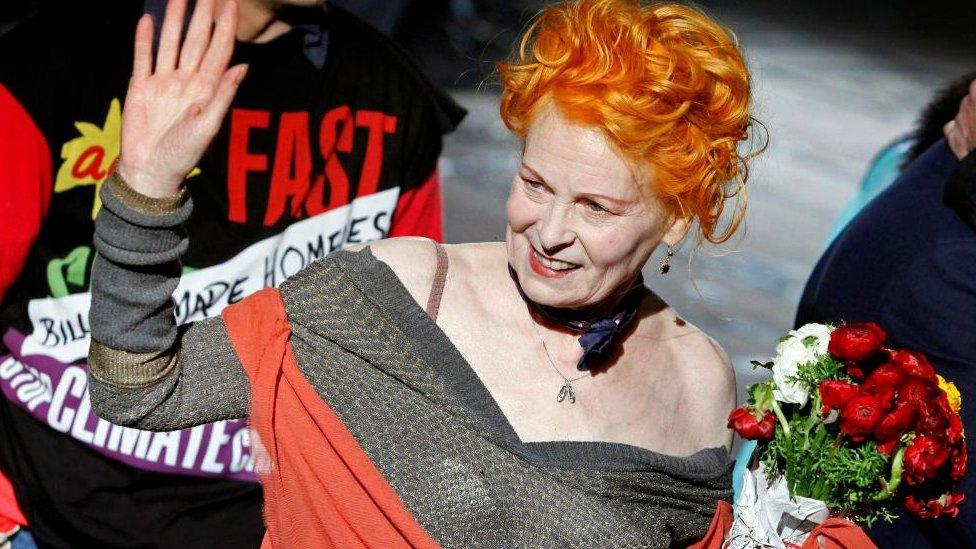Dame Vivienne Westwood - the godmother of punk
- Published
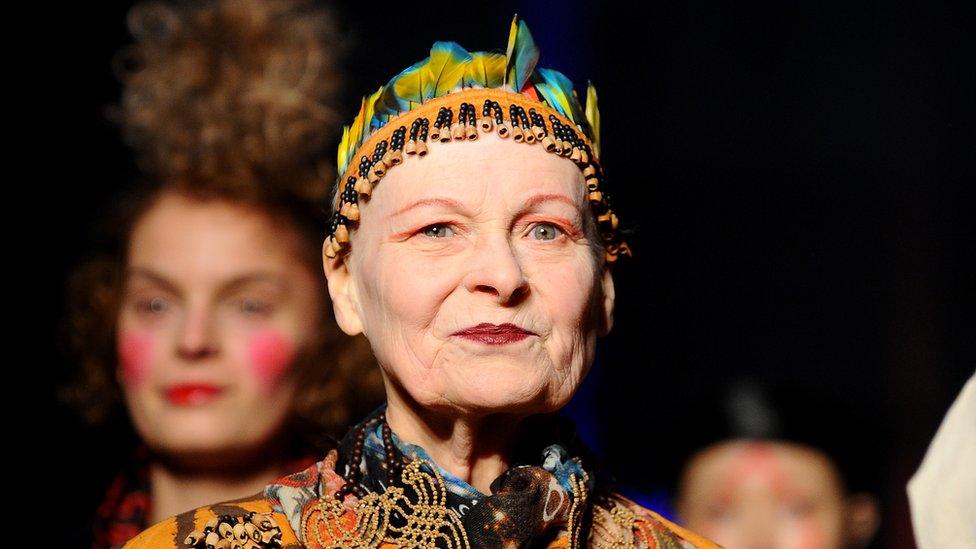
She was the anarchic idealist who stormed the battlements of the status quo and transformed Britain.
She was a would-be revolutionary, fired by a hatred of corruption and global injustice, who despaired at the indolent passivity of youth.
Vivienne Westwood gave birth to punk, conquered high-fashion and built a global empire. She invented New Romantics, sent Naomi Campbell down the catwalk wearing a traffic cone and turned up to meet the Queen having left her underwear behind.
For Westwood, fashion was a weapon. Of course, she thought, clothes made people sexy. But the point was to shake things up, to destroy miserable conformity and make a better world.
Vivienne Isabel Swire was born on 8 April 1941 in the Derbyshire village of Tintwistle, the oldest of three children.
Her working class parents were good with their hands. They encouraged her to make things, which she did with enthusiasm. But they were deeply puzzled by their daughter's addiction to reading, once paying her to destroy her library card.
She had an enviable self-confidence, believing herself an exceptional craftswoman. At grammar school in Glossop, she saw herself as "a kind of champion". "Honestly", she later said, "at the age of five, I could have made a pair of shoes".
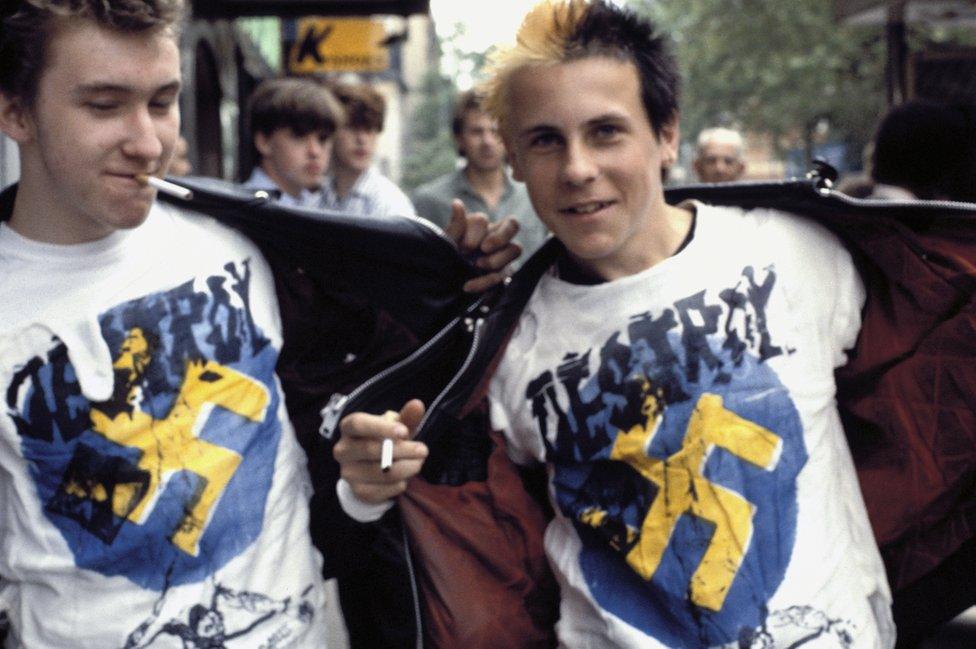
Two boys wearing Vivienne Westwood protest T-shirts. She wanted young people to get angry and change the world. They sadly disappointed her.
The family moved to North London in 1958. Vivienne dabbled in silversmithing at the local school of art but quit after a single term. Self-confident she may have been, but she failed to see how a working-class girl could make a living like that.
She qualified as a primary school teacher, then married Derek Westwood - handsome Hoover factory apprentice by day and flamboyant Mod by night. Westwood made her own wedding dress and jewellery. A year later, she gave birth to their son.
Then, a chance meeting changed everything. Her brother, Gordon, brought a 19-year-old, fellow art student round to her flat in Harrow. He had red hair and a face whitened with talcum powder. His name was Malcolm McLaren: self-declared genius and godfather of punk.
So began one of Britain's great creative partnerships. They moved into a tiny flat in Clapham, had a child and launched a cultural revolution that shook, and sometimes frightened, the world.
McLaren was impossible. His mother was a sex worker and he had been brought up by his eccentric grandmother, who lived by the motto "to be bad is to be good and to be good is just boring".

Vivienne Westwood with Malcolm McLaren. Together they shaped the sound and style of punk in the 1970s.
He was a peacock: intent on blinding small people with his brilliance, affronting an older generation he detested and belittling everyone but himself - especially Vivienne.
He took six days to visit her in hospital after the birth of their son, refused to be called 'Dad' and threatened to cart the child to Barnardo's when asked to pitch in. Westwood retreated to a caravan in Wales; hunting for wild vegetables while he ran riot in London and married another art student.
But attraction overcame everything. Her childhood had been happy, but a cultural desert. Creatively, McLaren was an awakening; introducing her to art, music and helping her transform "from dolly bird into a chic, confident dresser". Westwood rekindled the partnership, blossomed artistically and simply ignored the abuse.
Then came the Sex Pistols, snarling at the 1970s. McLaren embraced them as an angry pot-shot at the hippy movement he hated. Westwood opened a shop on the King's Road, conjuring the look the Pistols made famous. A bewildered world gasped and named it Punk.
She called the shop, 'Let It Rock', then changed the name to 'Too Fast To Live, Too Young To Die'. Finally, it was re-branded simply as 'SEX' - the huge pink sign above the door meant only the brave went in.

Only the brave entered Vivienne Westwood's shop on the King's Road. Westwood (far right) is pictured alongside her rather terrifying staff - including Chrissie Hynde (centre) and the legendary Jordan (with blonde beehive)
Inside, the staff were intimidating. There was Chrissie Hyde, Toyah Wilcox and, most terrifying of all, 'Jordan': a woman who actually received an Arts Council grant to be her indomitable self.
The clothes, of course, were like nothing else. They were radical and individualistic, sticking two-fingers up at rival street-fashions like flower-power, Teddy Boy and Mod.
It was as much anthropology as style. Bondage trousers and swastika jackets were, she explained, "sex translated into fashion becoming fetish". It was, she declared, "the very embodiment of youth's assumption of immortality".
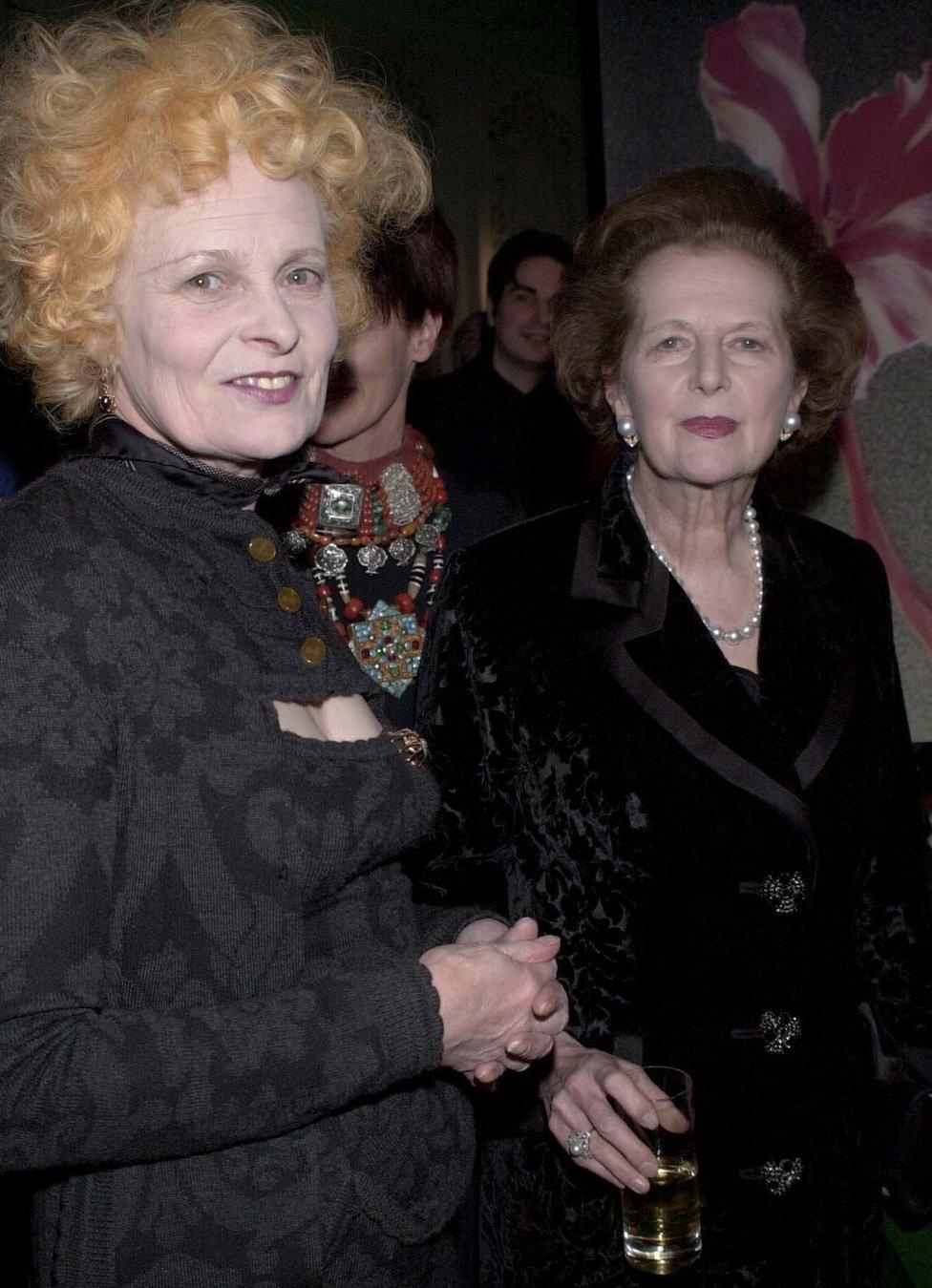
Vivienne Westwood loathed Margaret Thatcher's politics but she gave the former prime minister credit for her style and dress sense.
Westwood's parents hated Malcolm and were deeply shocked; but they gave her the money to get started and loyally offered practical help while "our Vivienne" filled the racks with studs, chains and nipple zips.
Westwood's rubber negligee, spiky hair, stilettos and pornographic T-shirt literally stopped traffic. She was having a ball, feeling like a "princess from another planet."
Later, McLaren would boast he was a "con man", a Svengali who twisted popular culture into nothing more than a convenient marketing gimmick. For Westwood, the movement was more profound; seeing it as as counter-cultural youth insurgency against the corruption of the old world order.
Punk, she earnestly believed, was more than fashion. The movement was political; the aim was revolution. When the young showed no inclination to stop spitting and build barricades, Westwood was bitterly disappointed.
She fell out with the Sex Pistols' lead singer Johnny Rotten: both claiming to have inspired the idea and title of Anarchy In The UK. But what frustrated her was that the spiky-haired musician had missed the message.
The clothes and music were supposed to channel rage and bring about change. But the young simply ignored global injustice, stuck safety-pins in their nose and moshed to the music. While Westwood and McLaren were full of revolution, it never happened. Westwood felt let-down, became disillusioned and, eventually, drifted on.

Queen of the catwalk: Vivienne Westwood built a global fashion brand and was named as one of the most influential designers of the twentieth century.
Instead, she took her subversive ideas and stormed the catwalks of London and Paris. Working alone on a little sewing-machine in her front room, Westwood put the pieces together using her own body as a template.
Intellectually inspired by a Canadian art historian, Gary Ness, she researched the history of fashion, reworked it with vengeance and dared the world of haute-couture to reject her. She put models in Harris Tweed, fine knitting, 'mini-crinis' and corsets that pushed their busts almost up to the chin.
The public sniggered. Westwood threatened to walk out of one BBC interview when the audience kept laughing. It didn't help that Russell Harty, a fellow guest, described one girl as a "walking chip shop." The Pistols sneered too, accusing her of abandoning punk and making "posh frocks for Ascot".
It wasn't easy; at times she came close to bankruptcy but the fashion world came to love her. Alongside McLaren, she put on legendary collections with names like Pirate, Savages and Nostalgia of Mud. And when he pushed off, she continued solo: kick-starting New Romanticism with designs that parodied the establishment. The establishment lapped it up.
In the end, she made a fortune. One show in Paris was over in the time it takes to hard boil an egg, but featured clothes worth more than one million pounds. When Sex and the City's Carrie Bradshaw wanted a wedding dress, she turned to Westwood. The woman who ran a shop on the King's Road had become a major global brand.
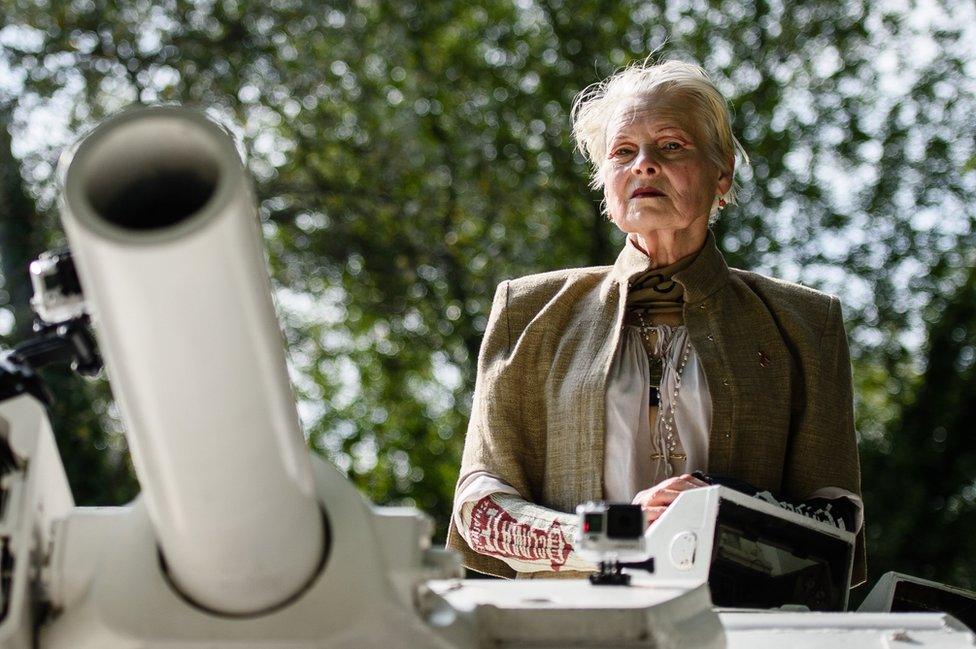
Vivienne Westwood campaigned on a range of environmental causes. She drove a white tank up to then prime minister David Cameron's constituency home in a protest against fracking.
In 1989, the hugely influential Women's Wear Daily magazine rated her one of the six best designers of the twentieth century; the only woman, alongside Armani, Lagerfeld and Saint Laurent. "As far as I was concerned," she said, "it was a statement of fact." When Naomi Campbell fell off her nine-inch purple platforms on the catwalk, the shoes simply flew off the shelves.
Westwood's success did not mean she had given up on revolution. Deeply political, her art had a purpose. She dressed models as punked-up debutantes, thumbing her nose at the ruling classes. Her clothes subverted the fashions that had historically subjected woman. She made T-shirts emblazoned with profane political slogans, selling them at a price.
Westwood loathed Tony Blair and Margaret Thatcher with a passion and threw herself into a life-long crusade to promote individual liberty, rid the world of nuclear weapons and combat the threat of climate change.
She supported Aids Research, PETA and Oxfam, gave hundreds of thousands to the Green Party and became a regular visitor to Julian Assange during his seven-year stint in the Ecuadorian embassy. She even parked a white tank outside David Cameron's house in a protest against fracking.
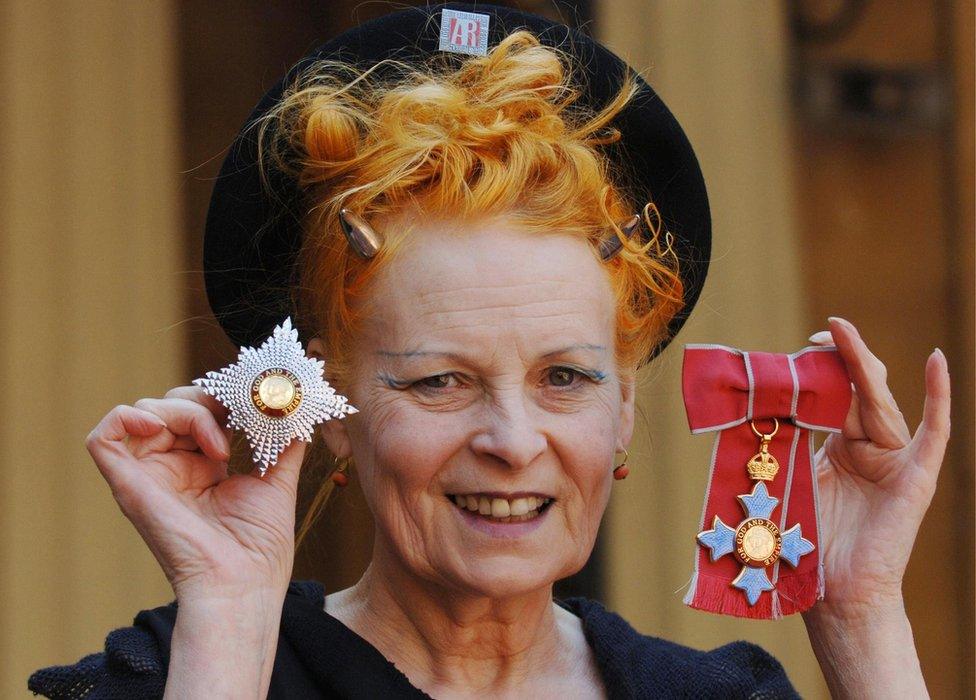
The eternal rebel became a Dame of the British Empire in 2006. On a previous trip to Buckingham Palace to pick up an OBE, she failed to wear underwear to meet the Queen.
Given an OBE in 1992, Westwood turned up without any knickers on, giving photographers the shock of their lives as she gave a twirl. If Her Majesty was not amused, she didn't show it and Westwood was back at the Palace a few years later when the legendary rebel became a Dame.
In 1992, Westwood married again, this time to an Austrian fashion student half her age. Andreas Kronthaler was calm and supportive: indeed everything that McLaren was not. The pair formed a new creative partnership, for years still working from Westwood's Spartan, ex-council flat.
Westwood said her favourite quotation was from Aldous Huxley, although it has been attributed to Bertrand Russell. "Orthodoxy", he said, "is the grave of intelligence". The shop she opened on the King's Road still operates. It's now called World's End, selling archive designs and slogan T-shirts, in memory of an icon determined to wage war against conformity.
The godmother of punk, empress of global fashion and Dame of the British Empire certainly did that.
- Published30 December 2022
